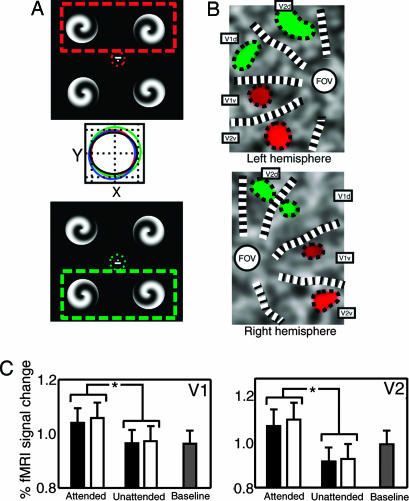Fig. 1.
Retinotopically specific attentional modulation in V1 and V2. (A) Four high-contrast spirals of random handedness were presented in the four visual quadrants. A small line close to central fixation indicated the two spirals whose handedness should be discriminated. A dashed box (not shown in the experiment) illustrates the spirals to be attended for two representative conditions, attend top (red) and attend bottom (green). Red and green dotted circles around fixation are ellipses plotting eye position during the experiment (mean ± 1 SD during 2-s stimulus presentation). Middle shows eye position under all attention conditions (attend top, red; attend bottom, green; attend left, blue; attend right, black) (grid lines = 0.5 degrees) and reveals no systematic differences. (B) Attentional modulation of cortical responses to the spiral stimuli in V1 and V2 (for representative participant J.G.). Color coding shows stimulus-driven regions with increased responses when either the top two spirals (red) or the bottom two (green) were attended. Attentional enhancement is retinotopically specific. (C) Effect of spatial attention on retinotopic activation averaged across all participants. BOLD responses extracted from the retinotopic representations of individual stimuli are plotted for both V1 (Left) and V2 (Right), averaged across each possible spiral location (separately for attended and unattended) and six participants. BOLD responses (error bar, 1 SD) are shown when the stimulus corresponding to the representation is attended, unattended, or for a fixation baseline. Black bars indicate responses in retinotopic loci when attention was directed to two spirals within either the right or left visual hemifield; white bars indicate corresponding responses when attention is directed to two spirals in different visual hemifields (as shown in A). Significant (P < 0.05) differences are marked with an asterisk. Attention enhanced responses relative to baseline; unattended stimuli evoked activity either at baseline or slightly suppressed. There was little difference in attentional modulation comparing within-field and between-field conditions.

